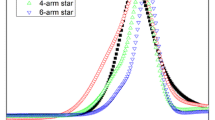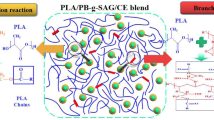Abstract
A polystyrene-block-polyisoprene ((PS-b-PI)3) star polymer was synthesized by photochemical reversible addition fragmentation chain transfer (RAFT) polymerization. The obtained star polymer was epoxidized and used as a toughening agent in an epoxy thermoset. The incorporation of the epoxidized star polymer resulted in the formation of nanostructures and it was fixed by a crosslinking reaction. The formation of nanostructures in the thermosets follows the mechanism of reaction-induced microphase separation. The mechanical properties such as toughness and tensile strength were considerably increased due to the nanostructures formed by reactive blending.













Similar content being viewed by others
References
Matyjaszewski K, Gnanou Y, Leibler L, (2007) Macromolecular engineering: precise synthesis, materials properties, applications. Wiley VCH. Vol. 4: 1–2982.
Adelsberger AM, Bivigou-Koumba A, Miasnikova P, Busch A, Laschewsky P, Müller-Buschbaum PCM (2015) Polystyrene-block-poly(methoxy diethylene glycol acrylate)-block-polystyrene triblock copolymers in aqueous solution—a SANS study of the temperature-induced switching behavior. Colloid & Polymer Science 293:1515–1523
Francis R, Baby DK, Gnanou Y (2015) Synthesis and self-assembly of chitosan-g-polystyrene copolymer. A new route for the preparation of heavy metal nanoparticles. Journal of Colloid and Interface Science 438:110–115
Touris A, Hadjichristidis N (2011) Cyclic and multiblock polystyrene-block-polyisoprene copolymers by combining anionic polymerization and azide/alkyne click chemistry. Macromolecules 44:1969–1976
Pinazzi CP, Menil A, Rabadeux JC, Pleurdeau A (1975) Polyisoprene and polybutadiene derivatives of potential biomedical interest. Journal of Polymer Science: Polymer Symposia 52:1–7
Kipnusu W, Elmahdy M, Treß M, Fuchs M, Mapesa E, Smilgies DM, Zhang J, Papadakis CM, Kremer F (2013) Molecular order and dynamics of nanometric thin layers of poly(styrene-b-1,4-isoprene) diblock copolymers. Macromolecules 46:9729–9737
Matmour R, Francis R, Duran RS, Gnanou Y (2005) Interfacial behavior of anionically synthesized amphiphilic star block copolymers based on polybutadiene and poly(ethylene oxide) at the air/water interface. Macromolecules 38:7754–7767
Li W, Wang H, Yu L, Morkved TL, Jaeger HM (1999) Synthesis of oligophenylenevinylenes-polyisoprene diblock copolymers and their microphase separation. Macromolecules 32:3034–3044
Kishi H, Kunimitsu Y, Imade J, Oshita S, MorishitaY AM (2011) Nano-phase structures and mechanical properties of epoxy/acryl triblock copolymer alloys. Polymer 52:760–769
Mijovic J, Shen M, Sy JW, Mondragon I (2000) Dynamics and morphology in nanostructured thermoset network/block copolymer blends during network formation. Macromolecules 33:5235–5241
Auvergne R, Caillol S, David G, Boutevin B, Pascault J-P (2014) Biobased thermosetting epoxy: present and future. Chem Rev 114:1082–1115
Hillmyer MA, Lipic PM, Hajduk DA, Almdal K, Bates FS (1997) Self-assembly and polymerization of epoxy resin amphiphilic block copolymer nanocomposites. J Am Chem Soc 119:2749–2751
Lipic PM, Bates FS, Hillmyer MA (1998) Nanostructured thermosets from self-assembled amphiphilic block copolymer/epoxy resin mixtures. J Am Chem Soc 120:8963–8971
Yi FP, Zheng SX, Liu TX (2009) Nanostructures and surface hydrophobicity of self-assembled thermosets involving epoxy resin and poly(2,2,2-trifluoroethyl acrylate)-block-poly(ethylene oxide) amphiphilic diblock copolymer. J Phys Chem B 113:1857–1864
Meng F, Zheng S, Li H, Liang Q, Liu T (2006) Formation of ordered nanostructures in epoxy thermosets: a mechanism of reaction-induced microphase separation. Macromolecules 39:5072–5078
Xu Z, Zheng S (2007) Reaction-induced microphase separation in epoxy thermosets containing poly(ε-caprolactone)-block-poly(n butyl acrylate) diblock copolymer. Macromolecules 40:2548–2555
Hu D, Zheng S (2009) Reaction-induced microphase separation in epoxy resin containing polystyrene-block-poly(ethylene oxide) alternating multiblock copolymer. Eur Polym J 45:3326–3331
Hermel-Davidock TJ, Tang HS, Murray DJ, Hahn SF (2007) Control of the block copolymer morphology in templated epoxy thermosets. J. Polym. Sci. Part B: Polym. Phys. 45:3338–3345
George SM, Puglia D, Kenny JM, Causin V, Parameswaranpillai J, Thomas S (2013) Morphological and mechanical characterization of nanostructured thermosets from epoxy and styrene-block-butadiene-block-styrene triblock copolymer. Ind Eng Chem Res 52:9121–9129
Robert B. Grubbs, Jennifer M. Dean, Margaret E. Broz, Frank S. Bates (2000) Reactive block copolymers for modification of thermosetting epoxy. Macromolecules 33:9522-9534-9540.
Otsu T, Yoshida M (1982) Role of initiator-transfer agent-terminator (iniferter) in radical polymerizations: polymer design by organic disulfides as iniferters. Makromol. Chem Rapid Commun 3:127–132
Ajayaghosh A, Francis R, Das S (1993) Polymer-bound S-benzoyl O-ethyl xanthate. A new heterogeneous photoinitiator. Eur. Polym. J. 29:63–68
Francis R, Ajayaghosh A (2000) Minimization of homopolymer formation and control of dispersity in free radical induced graft polymerization using xanthate derived macro-photoinitiators. Macromolecules 33:4699–4704
Francis R, Taton D, Logan JL, Masse P, Gnanou Y, Duran RS (2003) Synthesis and surface properties of amphiphilic star-shaped and dendrimer-like copolymers based on polystyrene core and poly(ethylene oxide) corona. Macromolecules 36:8253–8259
Mishra AK, Patel VK, Vishwakarma NK, Biswas CS, Raula M, Misra A, Mandal TK, Ray B (2011) Synthesis of well-defined amphiphilic poly(ε-caprolactone)-b-poly(N-vinylpyrrolidone) block copolymers via the combination of ROP and xanthate-mediated RAFT polymerization. Macromolecules 44:2465–2473
Stellman JM, Woodward AE (1969) Chain folding in poly(trans-1,4-butadiene) crystals. Journal of Polymer Science Part B: Polymer Letters 7:755–759
Chocair A, Eisenberg A (2003) Control of amphiphilic block copolymer morphologies using solution conditions. Eur Phys J E10:37–44
Zhulina EB, Adam M, LaRue I, Sheiko SS, Rubinstein M (2005) Diblock copolymer micelles in dilute solution. Macromolecules 38:5330–5336
Price C (2009) Micelle formation by block copolymers in organic solvents. Pure Appl. Chem. 55:1563–1572
Lei L, Gohy J-F, Willet N, Zhang J-X, Varshney S, Jerome R (2004) Tuning of the morphology of core-shell-corona micelles in water. I Transition from Sphere to Cylinder Macromolecules 37:1089–1094
George SM, Puglia D, Kenny JM, Jyotishkumar P, Thomas S (2012) Cure kinetics and thermal stability of micro and nanostructured thermosetting blends of epoxy resin and epoxidized styrene-block-butadiene-block-styrene triblock copolymer systems. Polym Eng Sci 52:2336–2242
Liu J, Sue HJ, Thompson ZJ, Bates FS, Dettloff M, Jacob G, Verghese N, Pham H (2008) Nanocavitation in self-assembled amphiphilic block copolymer-modified epoxy. Macromolecules 41:7616–7622
Francis R, Baby DK (2014) Toughening of epoxy thermoset with polystyrene block-polyglycolic acid star copolymer: nanostructure-mechanical property correlation. Ind Eng Chem Res 53:17945–17951
Acknowledgments
RF gratefully thanks Prof. Yves Gnanou (Dean, PSE Division, KAUST, Saudi Arabia) and Prof. R.S. Duran (LSU, USA) for useful discussions in making the precursor star polymer. RF and DKB thank CSIR and DST, Govt of India for research fellowship. RF and DKB also thank UGC and State Govt for financial support.
Author information
Authors and Affiliations
Corresponding author
Ethics declarations
Conflict of interest
The authors declare that they have no competing interests.
Funding
This study was funded by the Council of Scientific and Industrial Research Extra Mural Research Scheme (No. 01(2201)/07/EMR-II), Government of India.
Rights and permissions
About this article
Cite this article
Francis, R., Baby, D.K. A reactive polystyrene-block-polyisoprene star copolymer as a toughening agent in an epoxy thermoset. Colloid Polym Sci 294, 565–574 (2016). https://doi.org/10.1007/s00396-015-3810-6
Received:
Revised:
Accepted:
Published:
Issue Date:
DOI: https://doi.org/10.1007/s00396-015-3810-6




